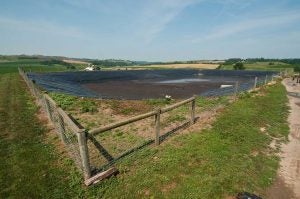With all of the opportunities it can provide, cattle manure should not be considered a ‘waste’ product in agriculture
What is both an asset and liability, simultaneously sold at a premium and yet a struggle to give away? The answer is cattle manure, both solution and cause to so many ails.
How much cattle manure a single farm or animal produces varies greatly by diet, environment, and region. But according to the U.S. Department of Agriculture’s Natural Resources Conservation Service, the amount of manure that livestock are producing has increased over the years, which is reasonable considering increased dry matter consumption and production levels.
Handling all of this in a way that is safe for public health, environmentally friendly, affordable and helpful to the farmers and the public sector isn’t an easy equation to solve.
On the farm level
Better technology and research have enabled farmers to better manage cattle manure on their own farms. After all, before it’s considered “waste,” manure is looked at as an agricultural resource — being full of things like nutrients, energy, organic matter, and even fiber. The issue is that it needs to be “recycled” or “bio-cycled” to some extent before some things are usable.
The most obvious on-farm manure usage is field application as an organic fertilizer. The three main nutrients in cow manure are nitrogen, phosphorus, and potassium. This works great for farmers because these are the three main nutrients crops grown to feed livestock take out of the soil. Essentially, farms that apply manure to their fields from their animals are putting back what they take out.
Applying manure instead of a synthetic fertilizer onto fields better enhances soil quality due to adding organic matter, helping to prevent runoff. Because of the additional content, including organic matter and fiberous materials, cattle manure can enhance soil properties like infiltration when applied correctly.
However, not all manure is created equal. The type — liquid, slurry, or solid — makes a difference in how it can be used. The way manure is stored and handled can also have an impact on nutrient quality. For example, manure with lots of added bedding can take longer to be absorbed by the soil. Some bedding types can take longer to biodegrade than others, and some, like sand, can harm the soil when too much is applied.
Likewise, even beneficial, high-quality manure fertilizers can be detrimental when not applied properly. This includes poor timing in the case of excessive rainfall or snowmelt before it can be fully absorbed, excessive application resulting in leachage and applying in areas topographically prone to runoff near waterways.
A lesser-known mode of farm manure is bedding. When manure is processed and treated, the fibers and solids can actually be used as a recycled bedding material, making farms more efficient and economical.
Outside applications
Off the farm manure is still valuable, and for much more than fertilizer.
A lesser-considered idea, but one certainly growing, is using manure as a source of biofuel. The nutrients in cow manure are extremely energy-dense, especially methane. As the materials are broken down and processed in a methane digester, the methane and GHGs are caught. The resulting energy from these gases can be collected and turned into electricity, clean natural gas, or biofuel for machinery. These applications go far beyond what can be used to cut back costs on the farm. With continued adoption, they even have the potential to be used to power communities.
The residual dry matter after manure is broken down in a digester can be used to apply on field with greater nutrient density and less environmental impact.
Like elephant dung, cow manure also has fibers with the potential to be turned into materials such as paper, textiles, and building materials.
And of course, we can always circle back to the good old-fashioned organic fertilizer and compost discussion. Bagged fertilizer and compost is a big industry. Composting is something even very small-scale farms and homesteads can do and create a value-added product According to Washington State University, natural compost has been known to sell as high as $30 a yard.
Manure can also be sold to other farmers, which is may be cheaper and more environmentally friendly than fertilizer alternatives. Some extension services even have calculators like this one to make sure both parties are getting a fair value.
Serious concerns
You can’t talk about cow manure without talking about the ugly side. Nutrient runoff, especially nitrogen, is detrimental to the environment, water quality, and ecosystem. While the composition of manure does help mitigate some runoff potential compared to direct liquid, chemical fertilizer application, the risk is still there especially when applied incorrectly.
Unfortunately, farmers usually have more manure than land to apply it on, according to the U.S. Environmental Protection Agency. If manure spreading equipment is not calculated properly, or at the wrong time, runoff from excess application can easily happen. According to the Chesapeake Bay Program, agricultural application was the largest contributor to the lake’s nutrient runoff.
Another issue is farms not having appropriate manure storage facilities. Even sold manure will leach into the surrounding ground and waterways if not under a covered building with concrete flooring and kept safe from the elements. Likewise, liquid storage as often seen use in hogs and dairies requires even stricter management. Often in the form of a manmade lagoon or an above ground tank, this kind of storage can overflow in the event of excessive rainfall or not being emptied often enough.
Manure handling is very costly, despite the on-farm fertilizer savings. For example, in 2014 the EPA established goals to prevent further pollution to the Chesapeake Bay. For years, this particular body of water has been on the EPA’s sights due to its long history of contamination. A big part of this discussion was the surrounding livestock farms within the watershed. It was estimated removing the manure from all those farms and applying it in an area safely outside the watershed would cost between $18 million and $30 million.
There are also the recurring expenses involved with of storing, handling, and moving manure. According to an NRCS bulletin, the average annual cost for a livestock operation is $2,509.

Practical handling
Farms that reach concentrated animal feeding operation (CAFO) status are required to have official Nutrient Management Programs, which go in depth on what their storage and application protocol is, as well as what to do in case of an emergency. However, even small farms could benefit greatly from having an unofficial plan following the same guidelines. In the event a farmer is accused of a runoff situation, a paper trail of records and protocols can be invaluable.
Being such a hot topic, manure management has repeatedly been on the public radar, often falling under heavy scrutiny. In response, there are lots of manure management resources accessible to farmers anywhere in the U.S. Land-grant university extension offices, such as Penn State and the University of Wisconsin, are very familiar with the laws and requirements for manure handling in their respective states. Anyone who has any sort of livestock, profit-driven or not, should familiarize themselves with the expectations, risks and practices for manure handling in their particular area.
Cow manure especially is a huge opportunity for additional profit for less work. Selling compost to locals is a great place to start. Additionally, some farmers have found success calling local garden centers that might be interested in retailing a bagged product or can direct them to companies that do.
Manure management is a tricky subject, and doing it well doesn’t happen by accident. Multiple solutions, including ones that could benefit everyone such as fertilizer and renewable energy opportunities, need to be made accessible and feasible. With continued research, innovation and commitment to doing the right thing, manure management can be made more of a solution and less of a problem.
Jaclyn Krymowski is a graduate of The Ohio State University with a major in animal industries and minor in agriculture communications. She is an enthusiastic agvocate, professional freelance writer, and blogs at the-herdbook.com.



